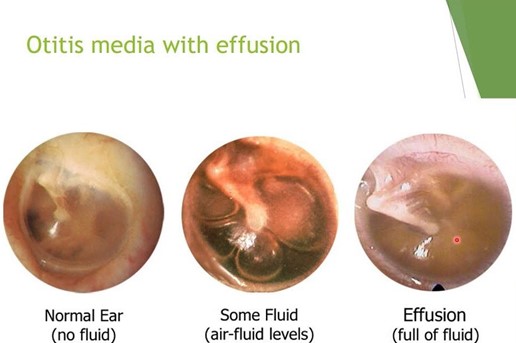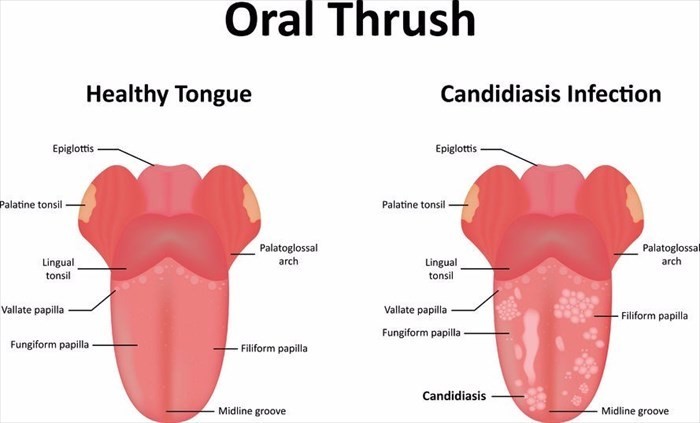A nurse is caring for a child who has otitis media with effusion. The nurse should identify which of the following manifestations indicates a tympanic membrane rupture.
Popping sensation when swallowing
Green-blue discharge in the ear canal
Sudden pain relief
Increased temperature
The Correct Answer is C
Choice A: A popping sensation when swallowing is not a sign of a tympanic membrane rupture, as it is a normal phenomenon that occurs when the eustachian tube opens and closes to equalize the pressure between the middle ear and the atmosphere. A popping sensation when swallowing may be associated with otitis media with effusion, which is a condition that causes fluid accumulation behind the eardrum, but it does not indicate a rupture.
Choice B: Green-blue discharge could be indicative of infection but is not as directly related to the rupture event as the sudden pain relief is.
Choice C: The correct answer is sudden relief of pain. This is because the rupture of the tympanic membrane releases the pressure and fluid that has built up in the middle ear, leading to an immediate decrease in pain.
Choice D: An increased temperature is not a sign of a tympanic membrane rupture, as it is a nonspecific symptom that may indicate various conditions, such as inflammation, infection, or fever. An increased temperature may be associated with otitis media with effusion, which is a condition that causes fluid accumulation behind the eardrum, but it does not indicate a rupture.

Nursing Test Bank
Naxlex Comprehensive Predictor Exams
Related Questions
Correct Answer is A
Explanation
The correct answer is: A. Tugging on the affected ear lobe.
Choice A reason:
Tugging on the affected ear lobe is a common sign of discomfort in children with otitis media. This behavior indicates that the child is experiencing pain or pressure in the ear, which is a typical symptom of this condition. Children often cannot verbalize their discomfort, so they may tug or pull at their ears to express their pain.
Choice B reason:
Erythema and edema of the affected ear are more indicative of otitis externa (swimmer's ear) rather than otitis media. Otitis media involves inflammation and infection of the middle ear, which is not typically visible externally. The primary signs of otitis media are observed through otoscopic examination, showing a bulging or erythematous tympanic membrane.
Choice C reason:
Pain when manipulating the affected ear lobe is also more characteristic of otitis externa. In otitis media, the pain is usually deeper within the ear and not exacerbated by touching the outer ear. The pain in otitis media is due to the pressure and inflammation in the middle ear space.
Choice D reason:
Clear drainage from the affected ear is not typical of otitis media. If there is drainage, it is usually purulent (pus-like) and indicates a ruptured eardrum due to the infection. Clear drainage is more commonly associated with conditions like otitis externa or a perforated eardrum without infection.
Correct Answer is B
Explanation
Choice A: Skin cancer is a malignant growth of the skin cells, which can be caused by exposure to ultraviolet radiation, genetic mutations, or immunosuppression. Skin cancer does not affect the mouth and does not cause a white, milky plaque. Skin cancer may cause changes in the color, shape, size, or texture of a mole or a skin lesion.
Choice B: Candidiasis or thrush is a fungal infection of the mouth, which can be caused by overgrowth of Candida albicans, a type of yeast that normally lives in the body. Candidiasis or thrush can occur in people who have a weakened immune system, such as those who have a systemic disorder, take antibiotics, immunosuppressants, or corticosteroids, or have a smoking history. Candidiasis or thrush can cause soreness in the mouth and difficulty eating. Candidiasis or thrush can also cause a white, milky plaque that does not come off with rubbing.
Choice C: Squamous cell carcinoma is a type of skin cancer that affects the squamous cells, which are flat cells that form the outer layer of the skin. Squamous cell carcinoma can occur in areas that are exposed to sun damage, such as the face, ears, lips, or neck. Squamous cell carcinoma does not affect the mouth and does not cause a white, milky plaque. Squamous cell carcinoma may cause a red, scaly, crusty, or bleeding bump or patch on the skin.
Choice D: Herpes simplex is a viral infection that affects the skin and mucous membranes, such as the mouth, lips, genitals, or eyes. Herpes simplex is transmitted by direct contact with an infected person or object. Herpes simplex does not cause a white, milky plaque. Herpes simplex may cause painful blisters or ulcers that burst and form scabs.

Whether you are a student looking to ace your exams or a practicing nurse seeking to enhance your expertise , our nursing education contents will empower you with the confidence and competence to make a difference in the lives of patients and become a respected leader in the healthcare field.
Visit Naxlex, invest in your future and unlock endless possibilities with our unparalleled nursing education contents today
Report Wrong Answer on the Current Question
Do you disagree with the answer? If yes, what is your expected answer? Explain.
Kindly be descriptive with the issue you are facing.
